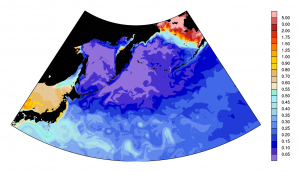Kazuhiro Misumi
Research summary
In the western North Pacific, primary production is limited by deficiency of iron. Diapycnal mixing supplies iron-rich water from depth to the sunlit surface water, and it is contributing to maintain high productivity and large biological CO2 draw in this area. We evaluate nutrient budget in the western North Pacific using a marine biogeochemical-cycle model coupled to a high-resolution ocean model. Our high-resolution simulation will provide detailed nutrient transport process from adjacent marginal seas to the western North Pacific and more accurate estimate of iron-supply rate to the surface water. Based on the understanding, we investigate influence of long-term variation of diapycnal mixing on marine ecosystem and climate especially focusing on role of iron-cycle change. Combination of integrated observation held in the A02-3 group and our numerical simulation will provide insight into iron transport process to the western North Pacific.
Dissolved iron distribution in the surface water simulated by a high-resolution model. We investigate role of ocean mixing on elemental budget in this area using the model.
Principal investigator:
Kazuhiro Misumi
Environmental Science Research Laboratory, Central Research Institute of Electric Power Industry, Scientist, Marine Biogeochemical Modeling
Collaborator:
Daisuke Tsumune
Environmental Science Research Laboratory, Central Research Institute of Electric Power Industry, Senior Scientist, Marine Biogeochemical Modeling
Collaborator:
Takaki Tsubono
Environmental Science Research Laboratory, Central Research Institute of Electric Power Industry, Scientist, Physical Oceanography
Collaborator:
Takeshi Yoshimura
Environmental Science Research Laboratory, Central Research Institute of Electric Power Industry, Scientist, Chemical Oceanography






